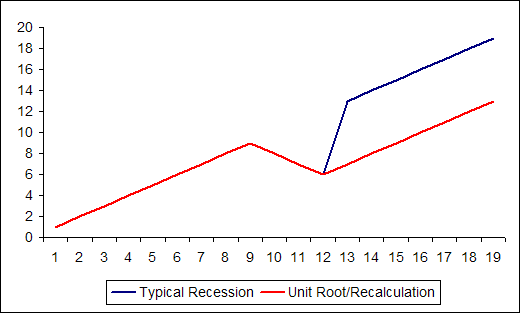Third Quarter Growth Revised Downwards
The BEA has revised its estimates for the third quarter’s growth down to 2.8% from 3.5%. This is also a bit below the expected growth of 2.9% for the quarter.
The main factors behind the downgrade: consumers didn’t spend as much, commercial construction was weaker and the nation’s trade deficit was more of a drag on growth. Businesses also trimmed more of their stockpiles, another restraining factor.
[…]
Still, the good news is that the economy finally started to grow again, after a record four straight losing quarters. The bad news is that the rebound, now and in the months ahead, probably will be lethargic.
The worst recession since the 1930s is very likely over, but the economy’s return to good health will take time, Fed officials and economists say.
So much for the strong, above normal growth that some have predicted. Not sure why they predicted this given that the last two recessions have followed this pattern. Yes, recessions from earlier decades tended to show higher than average growth, but that no longer seems to hold.
I like Arnold Kling’s recalculation view of the economy. Arnold explains the notion of recalculation thus,
But I think that the simplifying assumption of homogeneous output, labor, and capital is equally dangerous. My claim (which is not original with me–it is recognizably Austrian) is that a recession can be thought of as a recalculation. Imagine a central planner who decides to radically change plans. He has a huge recalculation to make in order to figure out where to allocate labor and capital. He says to some people, “Wait a minute. I am thinking. Some of you just have to stand idle while I figure this out.”
The market economy is like that central planner. We are undergoing a Great Recalculation.
Greg Mankiw brought this issue up by referring to the possibility of a unit root. In statistical models a unit root means that when you have a change it is permanent. To tie it to the current situation, if we have over invested in housing, then it is unlikely we can ever get back to where we were before the bubble bursts. This doesn’t mean we can’t have growth or even robust growth, but it isn’t going to be like previous recessions and recoveries a sharp decline in unemployment and output followed by and approximately equal rebound and then return to trend. We might simply return to trend from the lower level of unemployment and output. The following graph shows the two situations.

Kling continues,
In macro, we teach that there are different types of unemployment: structural unemployment, where there is a mismatch between skills and needs; frictional unemployment, where the skills and jobs match up in theory, but in practice people are stuck in the search process having not yet found the right match; and cyclical unemployment, where people are unemployed because of inadequate aggregate demand.
If Kling is right, then we are going to see structural unemployment because the economy is undergoing a structural change. Moving resources between sectors of the economy, and as a result we’ll likely see more people in the mismatch of skills problem than cyclical unemployment.
Back to Kling,
Up until about 1980, most of the unemployment in a recession was unemployment that I would recognize as cyclical. However, certainly since 2000, most of the unemployment has not met my definition of cyclical.
The old-fashioned inventory recessions involved one class of miscalculations–firms over-produced relative to demand, and then had to cut back for a while. Those miscalculations are less important today, in part because computerized inventory and integrated supply chains tighten the connection between production plans and reality, and in part because a lot of the actual production of stuff for U.S. consumption is done overseas, so our inventory miscalculations affect foreign workers relatively more and U.S. workers relatively less.
So while the stimulus might have lessened the impact of the recession, I don’t think it would ever get us back to the blue line. The only way to do that would be to have incredibly massive stimulus which is just not possible nor would it be sustainable.

I will only note that I have said “structural unemployment” in this blog’s comments in the past.
Quite an old post to cite, but a very good one that I liked a lot. Several other people have written similar items. I think that this will be a slower and longer recovery than normal. Even when companies start rehiring, I am expecting that people will use tech more than ever and employment will be slow. On the plus side, the illegals are leaving because of a lack of jobs so people will be able to claim those jobs when they come back. IOW, I think Kling is correct.
I think that in the long run we are going to need a different kind of educational system to cope with the rapidly changing job market. We have used colleges for education but also as a means of signaling. That will probably continue at the high end, but for most of the work force I think we will be looking less for degrees and more for focused education giving specific skills and knowledge needed for new jobs. I see intense 3 to 6 month courses becoming the norm rather than 4 years of parties and occasional cramming.
Steve
Steve